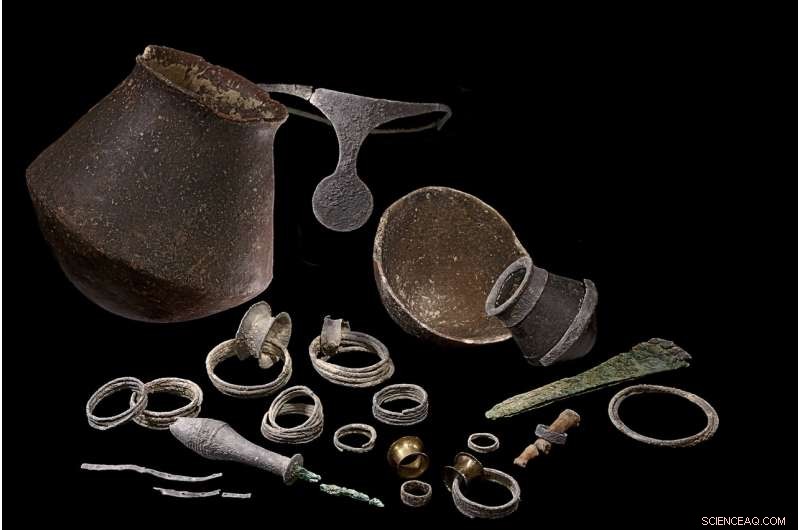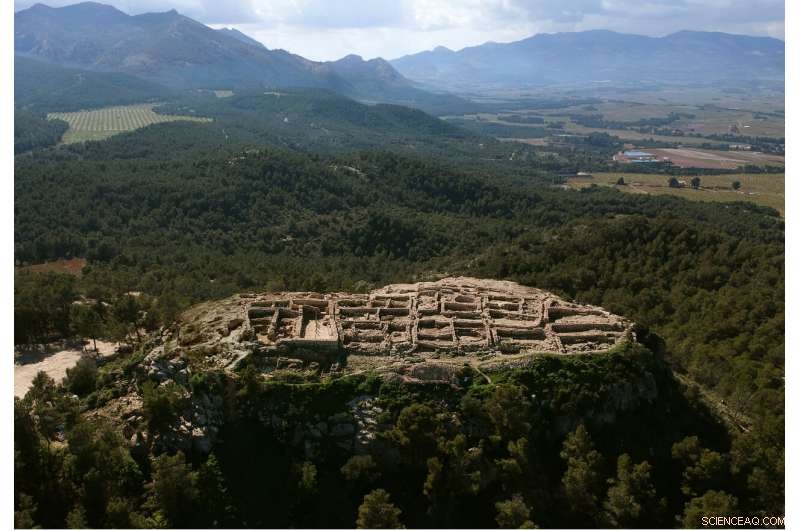
Parte dos bens funerários encontrados na sepultura 38 em La Almoloya. Crédito:Grup ASOME-UAB
As mulheres da classe dominante podem ter desempenhado um papel importante na governança de El Argar, uma sociedade que floresceu no sudeste da Península Ibérica entre 2200 e 1550 AC, e que nos últimos dois séculos de sua existência, desenvolveu-se na primeira organização estatal do Mediterrâneo Ocidental.
Estas são as conclusões a que chegaram pesquisadores da Universitat Autònoma de Barcelona (UAB) que conduziram um estudo analisando o conteúdo de uma tumba principesca (Sepultura 38), contendo duas pessoas e uma grande quantidade de itens valiosos. A tumba foi descoberta em 2014 no sítio arqueológico de La Almoloya em Pliego, Murcia, abaixo do que mais tarde foi identificado como o salão de governo de um edifício palaciano.
"La Almoloya e a sepultura principesca 38 pertencem a esses achados arqueológicos excepcionais, que de vez em quando fornecem um vislumbre dos súditos dominantes e dos objetos emblemáticos das primeiras sociedades estatais emergentes na Europa durante a Idade do Bronze, "afirma Vicente Lull, um dos coordenadores do estudo. Publicado em Antiguidade , esta pesquisa deu aos arqueólogos uma visão sobre o poder político e econômico da classe dominante em El Argar.
O enterro, localizado em uma grande jarra de cerâmica, apresentou dois indivíduos:um homem de 35 a 40 anos, e uma mulher de 25 a 30 anos. Ao lado deles estava uma série de cerca de 30 objetos de valor e prestígio, muitos dos quais foram feitos ou embelezados com prata e quase todos pertencentes a mulheres. Tinha um repertório de joias e objetos pessoais muito completo:pulseiras, tampões para os lóbulos das orelhas, colares, espirais e recipientes com ofertas de animais. O item mais notável foi um diadema de prata encontrado na cabeça da mulher.
Um estudo detalhado do diadema encontrado em La Almoloya e sua comparação com quatro outros encontrados no século 19 nos túmulos de mulheres ricas no local de El Argar, que dá nome à sociedade e cultura árgara, aponta para o fato de que todos eles, apesar de ser notavelmente uniforme, eram peças altamente exclusivas. Eles foram criados em uma oficina de ourives, como a recentemente descoberta em Tira del Lienzo, outro sítio Argaric escavado pela mesma equipe UAB alguns anos atrás.
“A singularidade desses diademas é extraordinária. Eram objetos simbólicos feitos para essas mulheres, transformando-os assim em sujeitos emblemáticos da classe dominante dominante, "explica Cristina Rihuete, que também participaram do estudo. “Cada peça é única, comparável a objetos funerários pertencentes à classe dominante de outras regiões, como a Bretanha, Wessex e Unetice, ou no Mediterrâneo oriental do século 17 AEC, contemporâneo de nosso túmulo 38. "
De acordo com pesquisadores, a opulência dos bens funerários encontrados nos túmulos das mulheres da elite de El Argar, em que os diademas são de particular importância, é uma indicação do papel distinto desempenhado por essas mulheres na governança de alguns desses assentamentos. Este é o caso de La Almoloya, berço da sociedade Argar e centro do poder político e econômico mais relevante da região.
Eram as mulheres governantes, ou os emblemas de poder usados por eles tinham apenas valor simbólico? Esta é a questão na qual a equipe de pesquisa está interessada. E a resposta deles é que muito provavelmente eles eram os governantes:"Na sociedade Argaric, mulheres das classes dominantes foram enterradas com diademas, enquanto os homens foram enterrados com espada e punhal. Os bens funerários enterrados com esses homens eram em menor quantidade e qualidade. Como as espadas representam o instrumento mais eficaz para reforçar as decisões políticas, Os homens dominantes de El Argar podem ter desempenhado um papel executivo, mesmo que a legitimação ideológica, bem como, possivelmente, o governo, tinha estado nas mãos de algumas mulheres, "eles discutem.

Vista aérea do assentamento. Credit:Grup ASOME-UAB
Biologically unrelated, but with shared offspring
According to the genetic analyses conducted at the Max Planck Institute, the individuals buried in Grave 38 were contemporaneous, and died simultaneously or close together in the mid-17th century BCE. They were unrelated, but did have a daughter, who was found buried near them. The woman had several congenital abnormalities, along with markings on the ribs that could indicate she had a pulmonary infection at the time of death. Enquanto isso, the male also had wear and tear on his bones indicative of extensive physical activity, possibly horse riding.
A value of 900 daily wages
The metal objects of Grave 38 also stand out in quantitative terms. The total weight of the silver is approximately 230 g, which is equivalent to 27.5 shekels, a currency used during the time of Hammurabi, the ruler of Babylon, in the first half of the 18th century BCE (contemporaneous with El Argar), and adapted by other Near Eastern and Aegean economies. Portanto, the silver found in La Almoloya would be enough to pay around 938 daily wages or buy 3350 kg of barley.
Notavelmente, the mean weight of the three medium-sized silver spirals worn by both individuals is 8.44 g, which matches the weight of the Mesopotamian shekel (8.33 g). Além disso, the weights of other silver spirals found in Grave 38 are practically fractions or multiplications of that figure. "This may be a random distribution or it may indicate a standardized system of weights and measures mirroring contemporaneous Eastern examples. Further research is required to determine this, but the possibility of detecting a metric system behind the silver spirals is a further indication of the extent of the economic control exercised by the dominant class in El Argar, " Roberto Risch, co-autor do estudo, points out.
Political unity among Argaric regions
Contrary to the tombs found in El Argar, where there is no knowledge of the space in which they were placed, the funerary goods in Grave 38 and the diadem did offer the possibility of interpreting their location within an architectural setting. "The presence of emblematic objects buried in such an important place as is the 'parliament' of La Almoloya could represent political unity among the Argaric regions during the last period of this society, in the 17th century BCE. The building was destroyed in a fire shortly after the burials took place, " explains Rafael Micó, also co-director of the project.
The El Argar society and the importance of La Almoloya
The El Argar society flourished from 2200 to 1550 BCE in the southeast of the Iberian Peninsula (Murcia and Almería), and represents an early Bronze Age society with urban centers and monumental constructions, a developed division of labor, intramural burials with marked asymmetries in funerary expenditure between individuals, political boundaries and institutionalized violence in the context of a class-based state society. The most important settlements are El Argar, La Bastida and La Almoloya.
The discovery of Grave 38 in La Almoloya, excavated in 2014 by researchers from the ASOME (Arqueoecologia Social Mediterrània) research group, affiliated to the UAB Department of Prehistory, pointed out the unique archaeological wealth of the site. A privileged, strategic location which helped this society thrive for over six centuries. The discoveries made, including a building with political functions and Grave 38, confirmed its importance as a center of political and economic relevance within the political territory of El Argar. The diadem found in La Almoloya is the only one to be preserved in Spain.